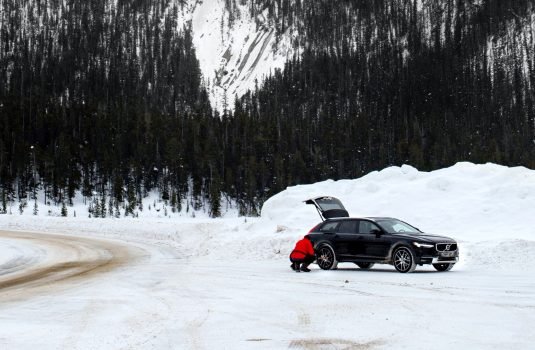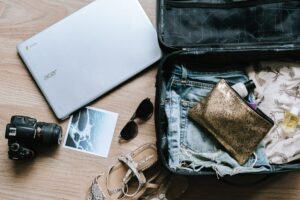Hi Winter Travelers!
When you’re traveling, especially if you travel in winter, it’s always a good idea to check weather conditions for your destination. Whether you are traveling for work or fun, you need to be aware of your surroundings. If roads are impassable because of severe weather, obey the law and do not attempt to drive on closed thoroughfares. However, if you’re traveling and the unexpected happens, keeping a Winter Storm Survival Kit in your vehicle can ensure that you’ll have the necessary supplies until assistance arrives. This kit can be as big or small as you want. Here’s a list of things you may want to include.
Battery booster cables
Car batteries can be finicky in winter, especially in freezing temperatures. If your car battery dies, booster cables can ensure that any passing car can restore it to working condition, even if they don’t have their own cables. Booster cables are an obligatory piece of winter equipment in some regions, but even if they are not where you live (or are traveling to), keep them close.
Blankets and/or sleeping bags
Being prepared for the worst case scenario may seem a bit fatalistic and unreasonable until you are actually caught in the worst case scenario. Most people would tell you that a sleeping bag isn’t necessary, but packing one just to be safe is a prudent course of action.
Bottled water
Most people carry bottled water whenever they go on a road trip – it’s important to stay hydrated, after all. However, when you are taking a trip in winter, maybe pack an extra bottle to have in reserve.
Cell phone/charger
Another item that most people don’t leave their homes without is a phone charger. We rely on our phones so much these days, that we simply can’t afford not to have enough charge in our devices. When packing for a road trip, make sure your charger is with you, and maybe pack a battery pack as well. It’s good to have one even if you don’t get stuck in a storm.
Road maps
Speaking of relying on technology, when is the last time you used a map? An old-fashioned paper map? To travel in winter without one is bold and perhaps ill-advised, especially if you don’t have an extra battery pack for your electronics. If you happen to be caught in a storm and can’t recharge your electronics, conserving the charge you do have may be critical. That’s where good old paper maps come in – they can lead you to where you need to go without sapping your phone’s battery.
Emergency flares/candles for travel in winter
In winter, the sun sets really quickly, especially far up north. Even though that may not be pleasant to drive in, it can help you if you get stuck. A flare will be much more visible at night and help rescuers find you. Emergency candles are also a useful thing to pack, as one candle can help you see and keep your car warm enough until help arrives.
First-aid kit
A first-aid kit is another item which is obligatory to have in your car in most jurisdictions. Simply put, in a case of emergency, you’ll be glad to have it, be it winter or summer.
Flashlight with extra batteries
Flashlights are mostly relegated to tool boxes and drawers full of useless junk nowadays for most people. Our phones have substituted even this handy device. That being said, there are a few situations where a flashlight may be useful. Having one in your car is one such example. Flashlights aren’t big or particularly heavy, but can be incredibly useful. Especially in situations where you need to conserve your phone’s charge.
Hand warmers
In line with a sleeping bag, hand warmers sound like overkill until you need them. If you’re not a fan of cold weather, you probably have them at the ready wherever you go in winter. Otherwise, invest in a pair, keep them in your car and you can forget about them. Think stoically. Should you never have to see them or use them – all the better. But if you need them, you’ll be glad you were prepared.
Tool kit
If you’re not tool-savvy, you may think that a tool box or a tool kit is wasted on you and that it will only add weight and bulk to your travel in winter. After all, you will need to pack a lot. Still, a small tool box shouldn’t take up much space, and it can be useful to have. Even if you cannot use it, someone you get stranded with might be more resourceful and know how to use it.
Windshield scraper/brush
If you’ve ever had to travel in winter, you know that you can’t even start your journey without using a windshield brush or a scraper – the buildup of snow and ice makes it impossible to see. However, not everyone keeps one in their car. This is plainly a mistake, as heavy snowfall can soon make restarting your journey even after a brief pause difficult, if not impossible.
High calorie, non-perishable food
Similarly to packing some water, packing food for a road trip is something most of us do even if we’re not expecting delays or trouble. If you’re taking a longer trip in winter, make sure to pack plenty of it. And make sure it’s nutritious and that it won’t spoil in a day. Things like dried fruits and nuts, as well as some protein bars are a good choice. If you get stranded, you will have enough to eat and it will sustain you for longer.
Knife
If a knife is not a part of your toolbox, it should be. Knives are fairly handy to have around. They’re good for protection, but also as a tool. The best part is that they can be pretty compact and foldable.
Shovel
Snow shovel may be a bit cumbersome to carry around, but it may also save you. In a snow drift, a shovel can help you dig out your car and get back on the road if everything else is fine. In fact, if you can find a small shovel, you solved even that problem.
Sack of sand
If you have room in your, bring a sack of sand. When the roads are slippery and covered in ice, something as simple as a sack of sand can help you immensely. Using sand for traction is, by some accounts even better than salt.
Small things can mean the difference between a safe winter trip and trouble. Just make sure you follow these safety tips, and you should come out the other side safe and sound.






